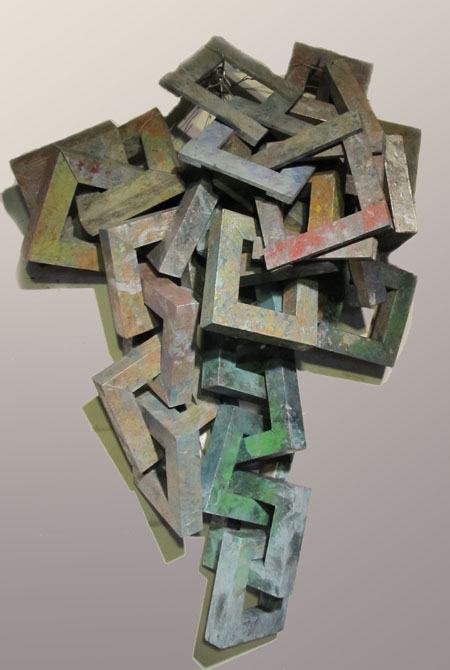After having invested heavily in plastic as a medium for my chains, I am temporarily reverting to wood.

Lightness, malleability, relative strength and the ability to take paint: these factors figured the choice to work in this medium during cabin fever season.
A quest, in whatever medium, has been to find a decent relationship between color textures and chains as such. Chains that pull and drag things around tend to have layers of worn paint, revealing portions of the underlying metal. I discovered that I can produce a rough analogue of that by floating oil paints on water and dipping the chains into the oil/water combination. Patterns and visual qualities emerge as one continues this process and a sense of history develops.

Jay,
Happy New Year!
What a wonderful technique, dipping the wood into oil paints floating on water! I love the different colors and the sort-of-antique quality.
Your present chain seems more compact than previous ones. Cabin fever kept you inside for a long time?
With respect to methods, I have been musing about paint surfaces. Having only used wood so far, I am tempted to try canvas. I thought that using polyester sounded interesting. However, there seems to be a divided opinion on the value of polyester canvas. An art magazine (which one?) seem to like it for its immortality. However, somewhere else I read that oil paint might not stick too well.
Birgit:
I checked with AMIEN and they are O.K. with polyester. They recommend applying a ground to the surface before painting in acrylics as the fabric tends to be very absorbent.
Now what AMIEN might think about my dipping process is another matter.
Nice work, Jay!!!
Jay,
Thanks for telling me about AMIEN. What a great resource that I had missed on.
Sunil,
Happy New Year! What are you painting now?
Another thank you for the info on http://www.amien.org. I just inherited some canvases and materials from the 1930’s and am going to do some research on the site.
Great color and structure in your chain “painting” too, it sets up some nice complex movements.
Sunil:
Thank you. I notice that you have changed your name. Is there a story behind that?
Kathy:
Thanks. As you might imagine, an interacting layer of oil color on water – which heretofore was used to decorate. endpapers for books – can create some interesting effects. For example if one dribbles and swoops enamel on the surface then a process sets in whereby the scrawl of paint begins to rearrange itself so as to reach a lower energy level. I have found that, if I spray some clear enamel onto the surface first, and let it dry into a hardened film, then subsequent applications of paint will tend to sit on this surface rather than interacting with the water. It is then a matter of laying the object to be painted onto this surface and lifting carefully, or dipping.